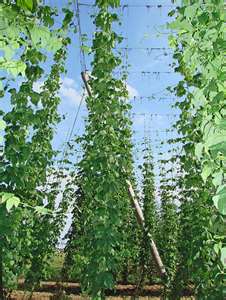Beer begins as a vat of sweet sugar water (the wort) made from malted grain. Centuries ago, brewers added bitter herbs and flowers such as dandelion, marigold, and heather to reduce the wort’s sweetness. Using hops to add bitterness to beer became common in Germany in the 13th century and slowly spread to other countries over the next 400 years.
Hops are the flowering cone of the vining plant Humulus lupulus that typically thrives in climates favorable to grapes. The plant is a vigorous, climbing, herbaceous perennial usually trained to grow up strings or wires in a hopfield when grown commercially. Hop plants are dioecious, meaning males and females flower on separate plants. Male flowers are undesirable for brewing beer so only females are grown in hopfields.
Hops are harvested in the fall and dried for long-term storage. This takes place in an oast house, a two- or three-story building where hops are spread out on upper floors to be dried by a wood- or charcoal-fired kiln below. Drying floors are thin and perforated to permit heat to pass through.
Hops reduce sweetness of the wort, contribute desirable flavors and aromas, and encourage activity of brewer’s yeast over less desirable microorganisms. They help remove unwanted proteins to make the beer more clear and have anti-bacterial properties to reduce spoilage and give beer a longer shelf life. This is accomplished by alpha acids, beta acids, and essential oils in the hop flowers.
- Alpha acids in hops range from 2% to 21% among the many varieties and, as a rule, the higher the percent the more bitterness the hop provides. Alpha acids become isomerized when heated, meaning that atoms of their molecules are rearranged to form a completely different molecule. During this process they gradually release bitterness to the boiling wort, which is why bittering hops are added at the beginning of the 60-90 minute boil.
- Beta acids range from 2% to 9% among hop varieties. These acids do not produce as much bitterness during the boil but, as alpha acid bitterness breaks down during fermentation and storage, beta acids slowly release bitterness through oxidation.
- Essential oils in hops contribute most of the flavor and aroma to beer. So the volatile oils don’t evaporate, flavoring hops are typically added during the last 15 minutes of the boil and aroma hops during the last five minutes. Variations on this process are first-wort-hopping, where a portion of the hops are added to the mash before the boil, and dry-hopping where hops are added after the boil at the beginning of fermentation. Each produces its own unique effects.

Hops are primarily a cultivar which is a plant or group of plants, such as roses, selected for desirable characteristics that can be maintained and improved by careful breeding. Hops are continually bred in many countries to improve bittering, aroma, and flavor qualities, to blend pleasing characteristics of different varieties, and to make them more resistant to disease.
The term noble hop refers to four varieties of hops which are low in bitterness and high in aroma. These are Hallertau, Tettnanger, Spalter, and Saaz named for the specific region or city in Bavaria or Bohemia where they were first grown. These are well-suited for European style beers.
US hop varieties include Chinook for pale ales, Columbus for IPAs, and Mount Hood for lagers, all grown in the Pacific Northwest. Hops used in other countries include Admiral, Fuggle, and Goldings in English ales, Hersbrucker in German pale lagers, Lublin in Polish lagers, Pride of Ringwood in Australian pale ales, and Strisselspalt in French continental lagers.
The many flavors and aromas these and more than 50 other hop varieties bring to beer are spicy, flowery, pungent, woody, dusty, earthy, grassy, herbal, mint, pine, hay, evergreen, berry, apricot, pear, grapefruit, pineapple, tangerine, black current, and passion fruit. Continuous experimentation by hop growers and beer brewers guarantees an ever-increasing variety of beer for the future.

